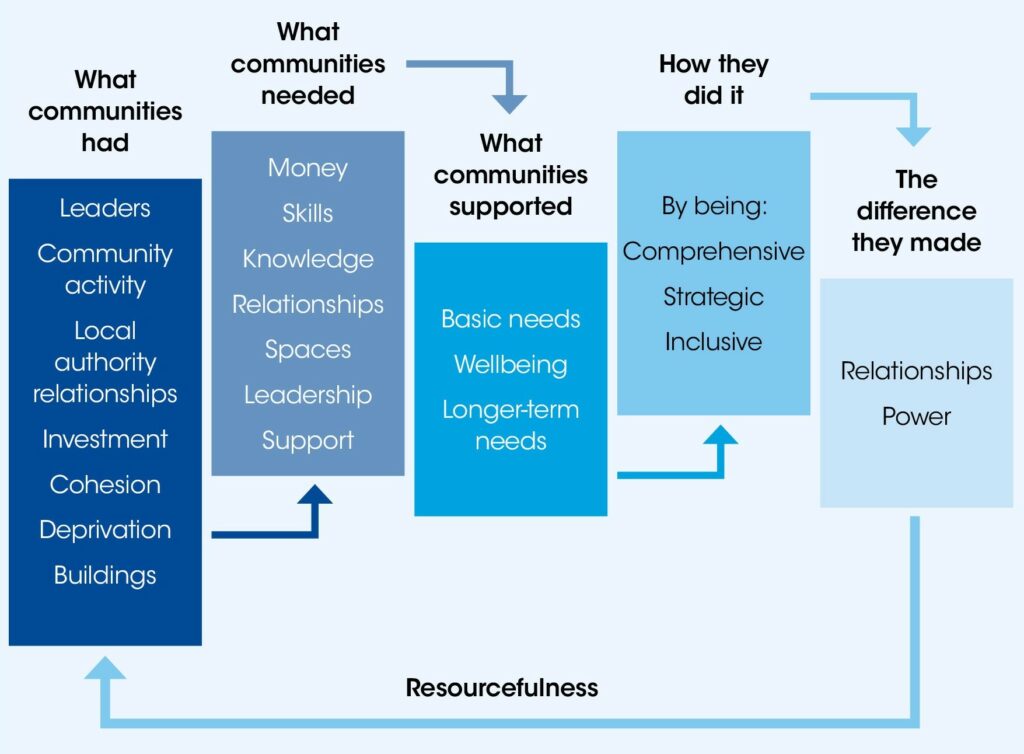Modelling resourcefulness: exploring community responses to COVID-19
As we publish the final report in our research series on communities responding to COVID-19, the research team at the Third Sector Research Centre explore a ‘model of resourcefulness’ and the complex factors at play in community responses to the pandemic.
For the past two years, we’ve been following 26 communities in England, observing their responses to the COVID-19 pandemic. Today, we publish the final report in our research series, One pandemic, many responses: How community responses to COVID-19 developed and why they varied.
Over the course of the pandemic, all the communities have shown themselves to be resourceful within their different contexts and circumstances.
They have all developed creative solutions to the enormous and long-lasting shock that the pandemic represented, mobilising a range of resources to respond to basic community needs.
Many have also worked together to enhance individual and community wellbeing, whilst also recognising the need to address deep-seated and longer term issues such as poverty and mental ill health.
Comprehensive, strategic and inclusive responses
However, exactly how communities have responded has varied, and some communities were better placed than others to develop a full response. The strongest responses were those that were:
- comprehensive in terms of the needs they sought to address and the activities involved
- strategic in terms of the understanding of needs, coordination of efforts and adaptability of the response
- inclusive in terms of who was supported and who was engaged in delivering the response.
Understanding why community responses varied is important for moving forwards, if we are to use those learnings to inform responses to future crises.
Resisting straightforward explanations
There is a temptation to seek straightforward explanations for the differences in community responses to the pandemic. Some observers, for example, have suggested it reflects variations in levels of social capital.
Our findings provide a more nuanced understanding and what has emerged is more complex. Our research shows the differences between communities were shaped by the interaction of multiple different factors:
- The strength of the network of community leaders
- Existing community activities and the connection between them
- Strength of relationships with local authorities
- Feelings of community cohesion and identity
- Past and present investments in communities
- Having or creating physical and/or virtual spaces
- Levels of deprivation
None of these elements alone explained the variation in community responses, and none were mutually exclusive or static.
While the first three – community leaders, community activity and relationships with local authorities – were identified as being particularly significant, it was clear that all helped to shape how individual communities responded.
Our findings emphasise the nuance and complexity of explaining differences in how communities responded to COVID-19.
A model of resourcefulness
Our research shows that the ways in which all seven contextual elements worked together was key.
High levels of deprivation and low levels of community cohesion could, for example, work to constrain responses, but this could be mitigated by having a strong network of leaders, strong existing community activities and strong relationships with the local authority.
Together, these different elements also influenced the availability of the resources required by communities to mount a response: money, skills, time, knowledge, relationships, space, leadership and support.
When these resources were most readily available, responses were at their strongest and communities were able to deliver activities which sought to meet basic needs, to enhance individual and collective wellbeing, and to address deep-seated and longer term needs.
Together, this can be thought of as a model of resourcefulness:
The ‘COVID decade’ ahead
Each of the 26 communities in our study has been deeply affected by the experience of mobilising during the pandemic – and while some have been left feeling united and powerful, many are feeling tired, unsupported and apprehensive about their future role.
This is especially the case given the prospect of a ‘COVID decade’ ahead, as the long term impact of the pandemic plays out alongside a cost of living crisis and public services struggling to get back on track.
The resourcefulness that communities have demonstrated over the last two years is unlikely to be sustainable without additional support.
With restrictions lifted and, we hope, the worst of the pandemic behind us, there is a pressing need for a more explicit conversation about who should be responsible for responding to community needs, in a context of raised expectations and squeezed resources.
Read more in-depth reports, briefings and blogs from the Communities responding to COVID-19 research study >
The study into communities responding to COVID-19 was undertaken by a coalition of researchers, led by Angus McCabe at The Third Sector Research Centre (TSRC) at the University of Birmingham.

